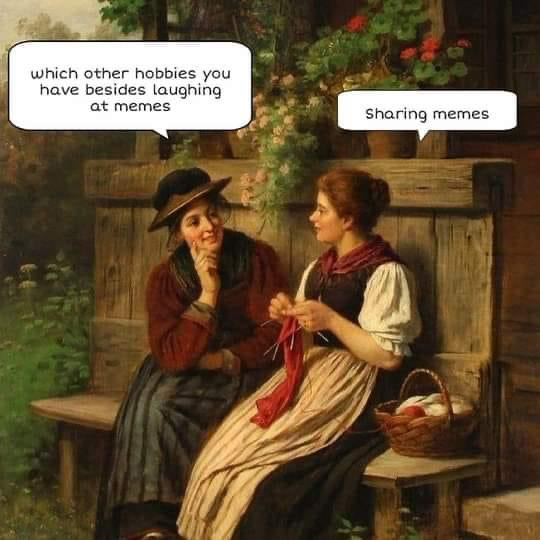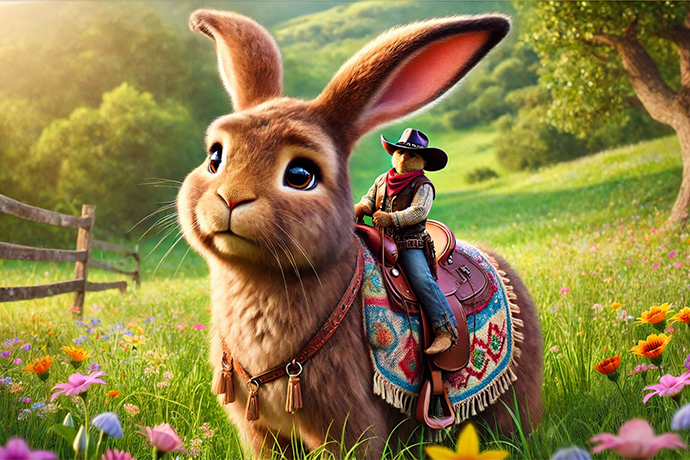No, sadly that is not a real bunny. It’s what ChatGPT did with a bunch of words I typed describing what a horse-sized bunny might look like. With a little humor tossed in like the saddle and Slim Pickens as the rider. Today you can learn why bunnies are not big as horses, how music affects the human body, the digital money used in Kenya, and more fun projects kids might enjoy when stuck at home over the holidays. Thanks for being here.
Holiday STEM Projects: Flip Books and LEGOs
Now that we’re in the holiday season, I want to continue with project ideas that might be fun and help kids learn about STEM. While keeping them from being too bored. Flip books are very hands on and can be fun with a great idea. And you don’t need expensive materials. Nor do you need dozens of cards to get the effect. I’ve also included an interesting article about using LEGOs to create holiday projects like tree ornaments. Mostly, it’s the process of coming up with ideas that’s important. Whether the end result is flip book or a fun LEGO object.
And last, I have links about zines. They’re more elaborate than flip books. A zine can help kids focus and capture their thoughts and feelings in a creative way.
Flip Books
How To Make A Flip Book For Kids!!!
https://youtu.be/c8ialIhxI_M
How to Make a High-Quality Flip Book
https://www.instructables.com/How-to-Make-a-High-Quality-Flip-Book/
Let’s Make a Flipbook
https://www.instructables.com/Lets-Make-a-Flipbook/
LEGOs
LEGO STEM holiday building
https://stemactivitiesforkids.com/simple-stem-lego-holiday-building/
Zines
How to Make a Zine
https://www.tate.org.uk/kids/make/cut-paste/how-to-make-a-zine
https://www.youtube.com/embed/AAyYHMldD_0
Learn How to Make Your Own Zine
https://www.youtube.com/embed/C8zP7wbwyt8
How to Make a Zine: A Kid-Friendly DIY Guide
https://www.readbrightly.com/how-to-make-zine/
Creative Writing For Kids: Making Zines!
https://www.youtube.com/embed/nAlZ2nR3Qkw
25 “Create Zine” Ideas & Tips for Everyone
https://publuu.com/knowledge-base/25-amazing-zine-ideas/
Zine History
https://www.slideshare.net/sardonicsmile/zine-history
Zines for Kids
https://www.zinelibraries.info/zines-for-kids/
Whatcha mean, what’s a zine? : the art of making zines and minicomics
https://search.worldcat.org/title/836092872
Bunnies Big as Horses
Non-scientists may not notice how rabbits and rodents are the same. But biologists notice. They see lots of size differences in rodents, from tiny to huge. They wonder why rabbits lack the same differences in size. To them, if rabbits had the same size differences as rodents, we’d see small rabbits and rabbits big as horses.
Biologists in Japan discovered the reason we don’t have horse-sized bunny rabbits. They looked at the fossil record. Turns out that the smallest hoofed animals — like sheep — predict the size of rabbits. Small hoofed animals compete with rabbits for food and space. Rabbit evolution limited them to be no bigger than what we have today. Meanwhile, rodents range from 3 to 12 gram pygmy mice to a capybara that can weigh 60 to 200 pounds.
Science aside, it is a fun exercise to imagine rabbits big as horses. We could put saddles on them. It would be like riding a bucking bronco. Given how fast they breed, though, likely they would be everywhere too. But the real horse bunny problem has to do with their teeth. They might turn into carnivores, meat eaters. Like bears. The hardest part might be growing carrots big enough to keep them tame. They can’t eat us while eating a carrot. It’s equally possible they’d be like Bugs Bunny, smart alecks with a sense of humor. That would be fun.
And as for the photo (sort of) above of a horse sized bunny with Slim Pickens in the saddle, I created it with ChatGPT. This was the prompt I used if you’re easily amused and enjoy long wordy descriptions: “Imagine a gigantic, adorable brown bunny rabbit, its fur soft and fluffy, glistening in the sunlight. This bunny is the size of a horse, with big, expressive eyes and long, floppy ears that twitch with curiosity. It wears a cozy, colorful saddle fitted perfectly on its back, adorned with whimsical patterns. The saddle features little pockets for treats, and there’s a gentle smile on the bunny’s face, inviting everyone to take a ride. In the saddle is the actor Slim Pickens dressed in cowboy gear, leather chaps and a cowboy hat. Surrounding it is a lush, green meadow, dotted with wildflowers, making the scene even more enchanting!” Too much fun. And I’m a little ambivalent given how much water and energy are used to create these images. This is my first attempt at AI generated images, possibly my last.
Why aren’t rabbits and hares larger?
https://onlinelibrary.wiley.com/doi/10.1111/evo.14187
Where’s my horse-sized rabbit?
https://www.kyoto-u.ac.jp/en/research-news/2021-04-22
Rabbits the Size of Horses – Why Not?
https://scitechdaily.com/rabbits-the-size-of-horses-why-not/
Scientists find a reason rabbits aren’t as big as a horse
https://newatlas.com/biology/rabbit-size-limited-herbivore-competitors/
M-Pesa
It’s easy to take money for granted. It’s either cash bills and coins or done digitally with credit cards and bank payments. But imagine you live in a rural area with only phone service. No banks nearby, no real cash. And if you had cash, someone might steal it.
In the early 2000s in Kenya, people started to use mobile phone airtime as a payment method. Instead of paying cash or using digital money. Something like 80% of Kenyans had mobile phones but many had no bank accounts.
Trading mobile phone airtime evolved into something called M-Pesa. In the Swahili language, pesa means money. A regional phone company, Safaricom, operates the service. You send text messages to pay or receive payment. And you work with the thousands of local retail agents spread all over the country. The agents handle any cash deposits or withdrawals. They also provide support help. As long as you don’t lose your phone, or the battery dies, you can buy things and make money.
M-Pesa is not like PayPal, Venmo, or other digital wallet companies. You don’t need a bank account to use it. And no phone app is required. Safaricom stores user account data securely. And people use their phones to access their account information and to send or receive money.
What interested me is that the technology helps people without using banks. But banks are part of the M-Pesa system. The retail agents work with banks to manage their activities. They act as a bridge between banks and the many people who don’t have accounts. And users get a convenient way to work with money without a bank. It’s a great example of using existing technology to solve a problem.
Mobile currency in Kenya: the M-Pesa | Centre for Public Impact
https://centreforpublicimpact.org/public-impact-fundamentals/mobile-currency-in-kenya-the-m-pesa/
Technology and Innovation: M-Pesa
https://www.vodafone.com/about-vodafone/what-we-do/m-pesa
Mobile Payments go Viral: M‐PESA in Kenya
https://workshop1.cases.som.yale.edu/sites/default/files/cases/MPeso/M-PESA\_Kenya.pdf
What Is M-Pesa? Definition, How the Service Works, and Example
https://www.investopedia.com/terms/m/mpesa.asp
Impact of Music on the Human Body
Listening to music and playing music can have a huge effect on your body. If you feel low, for example, sad music can make you feel worse. More upbeat music might lighten your mood. But has other effects music on the human body.
Musicians are both physically connected to music and affected by listening. The act of strumming a guitar, blowing a trumpet, or playing a violin is very physical. There’s the motion of your arms and hands and your posture. Plus there’s the sounds from your instrument and other musicians if you’re in a group. The sounds can affect your heart rate and breathing. Playing an instrument also uses both sides of your brain. It involves problem solving, memory, and creativity.
Listening to music also can release dopamine — which makes you feel happy — and lower cortisol. If you don’t know, cortisol helps reduce or increase your feelings of stress. Music also affects your emotions, from active to sleepy, happy to sad.
Probably most interesting is what parts of music affects us. There’s rhythm and volume of music, of course. A fast rhythmic beat makes people want to move and dance. And loud music can increase your heart rate and make you feel overwhelmed and stressed out.
But there’s also the frequencies we hear when listening to music. A frequency is the rate per second of a vibration that makes a sound wave. We measure these sound waves in hertz (or Hz).
High pitched notes might sound annoying. While low-pitched bass sounds can vibrate your body like a drum. Ever sit at a traffic light next to a car with their stereo bass cranked up? The vibrations thumps your car and your body.
There’s also supposedly a healing frequency (432hz) that reduces stress. Gregorian chants from the 9th and 10th centuries use this frequency for meditation. People also say it increases the body’s ability to heal from injuries. Science has yet to prove it, however. But music is sound waves and water is a good conductor for sound. So maybe our bodies having lots of water are affected? It’s unclear at this point if there’s any connection. Definitely music therapy works for some people.
When you listen to music, or play a musical instrument, definitely pay attention to how it affects your body. Or if you feel stressed, listen to calming music.
Music and health
https://www.health.harvard.edu/newsletter_article/music-and-health
How Music Resonates in the Brain
https://magazine.hms.harvard.edu/articles/how-music-resonates-brain
How does music make you feel?
https://www.bps.org.uk/psychologist/how-does-music-make-you-feel
How Music Can Influence the Body: Perspectives From Current Research
https://voices.no/index.php/voices/article/view/2308/2063
Effects of pitch and musical sounds on body-representations when moving with sound
https://www.nature.com/articles/s41598-022-06210-x
Music Tuned to 440 Hz Versus 432 Hz and the Health Effects: A Double-blind Cross-over Pilot Study
https://www.sciencedirect.com/science/article/abs/pii/S1550830718302763
Exposure to Music Alters Cell Viability and Cell Motility of Human Nonauditory Cells in Culture
https://www.researchgate.net/publication/305275235_Exposure_to_Music_Alters_Cell_Viability_and_Cell_Motility_of_Human_Nonauditory_Cells_in_Culture
Gregorian Chant
https://en.wikipedia.org/wiki/Gregorian_chant
Question: What are clouds made of?
In a word: water vapor. Ok that’s two words. Clouds hold bazillions of teeny tiny water vapor that can form into small rain drops. Rain drops form when water vapor condenses around dirt or salt or bacteria in the air. If clouds are cold enough, these rain drops become big enough to fall to earth.
Where does water vapor come from? That’s the most interesting thing about clouds. It’s not that clouds are beautiful and amazing and interesting. They are.
What makes clouds interesting is that they’re part of the water cycle. And the water cycle is what make much of life possible on earth. When rain falls to the ground, it collects in puddles and pools and lakes and rivers. The sun evaporates some of this water into the microscopic water vaport that rises into the air. Once airborne, the vapor can become rain that falls back down to the ground.
Why don’t clouds fall to the ground? Well, clouds are extremely heavy once vapor forms into clouds. They’re also very cold up in the atmosphere. Warmer air below the clouds keeps them airborne.
Also interesting about clouds is that there’s five kinds. Cumulus, cirrus, stratus, cumulonimbus, and nimbostratus. The links below have lots of neat photos and more details.
How do Clouds Form? – NASA Climate Kids
https://climatekids.nasa.gov/cloud-formation/
What Are Clouds? (Grades 5-8) – NASA
https://www.nasa.gov/learning-resources/for-kids-and-students/what-are-clouds-grades-5-8/
What Are Clouds? (Grades K-4) – NASA
https://www.nasa.gov/learning-resources/for-kids-and-students/what-are-clouds-grades-k-4/
Cloud – National Geographic
https://education.nationalgeographic.org/resource/cloud/
All About Clouds for Kids: Types and Names of Clouds – FreeSchool
https://www.youtube.com/watch?v=QAqeFSa60TE
This Week
Our Sunday email this week will have fun often offbeat links about thousands of displaced parrots inflicting revenge, the world’s oldest termite mound (34,000 years young!), students hacking Meta glasses to dox (identify) people without their knowledge and consent, smart TVs spying on us, and more. Look for the email this Sunday.


